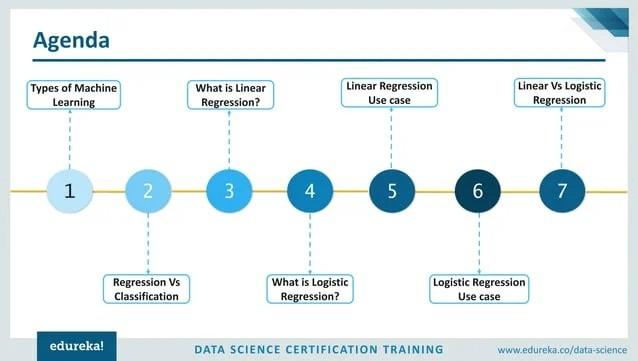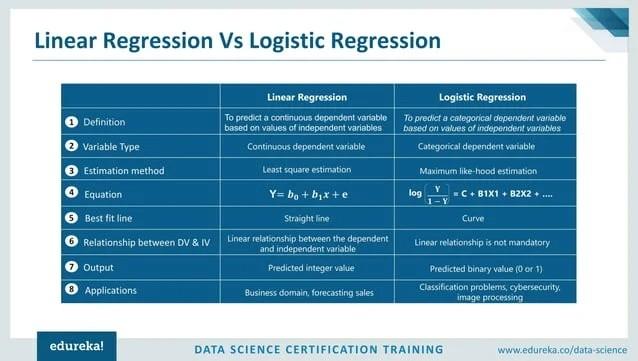LINEAR REGRESSION & LOGISTIC REGRESSION
 By Harshita Dubey
By Harshita Dubey

 By Harshita Dubey
By Harshita Dubey
• Regression is a method for determining how independent features or variables relate to a dependent feature or result. It is a technique for machine learning predictive modelling, where an algorithm is used to forecast continuous outcomes. We will be able to automate most of our job thanks to these devices' ability to link and communicate with one another as well as with their surroundings. IoT nodes need security, frictionless authentication, resilience, and ease of maintenance in order to connect with one another.
• Both the popular machine learning algorithms linear regression and logistic regression are offshoots of supervised learning. When solving regression issues, linear regression is employed, and when solving classification issues, logistic regression used.
Figure 1 : Agenda / Flowchart representation of ML types [source : edureka.com]

Machine learning algorithms can be trained in a variety of ways, each with its own benefits and drawbacks, as with any method.

Figure 3 – Regression Vs Classification [source – edureka.com]

The main distinction between classification and regression algorithms is that classification algorithms are used to predict/classify discrete values such as Male or Female, True or False, Spam or Not Spam, etc. while regression algorithms are used to predict/classify continuous values such as price, salary, age, etc.
Email spam detection is the ideal example to use in order to comprehend the classification issue. When a new email arrives, the model determines whether it is spam or not based on training data from millions of emails on various parameters. The email gets placed in the Spam folder if it is considered spam.
Example of Regression: Let's say we want to forecast the weather; in which case we will apply the Regression technique.
When making a weather prediction, a model is trained using historical data; once trained, the model is capable of making accurate forecasts for the following days.
Figure 4 – Regression Vs Classification [source – edureka.com]

A machine learning algorithm based on supervised learning is linear regression. It executes a regression operation.
Regression uses independent variables to model a goal prediction value. It is mostly used to determine how variables and forecasting relate to one another.
Regression models vary according to the number of independent variables they use and the type of relationship they consider between the dependent and independent variables.
The task of predicting a dependent variable's value (y) based on an independent variable is carried out using linear regression (x). Therefore, x (the input) and y (the output) are found to be linearly related by this regression technique (output). Thus, the term "linear regression" was coined.
Figure 5 – Linear Regression [source – edureka.com]

Figure 6 – Linear Regression [source – edureka.com]

An illustration of supervised learning is logistic regression. It is used to determine or forecast the likelihood that a binary (yes/no) event will occur. One use of machine learning to identify whether a person is likely to have the COVID-19 virus or not is an example of logistic regression.
A statistical analysis method called logistic regression uses previous observations from a data set to predict a binary outcome, such as yes or no. By examining the correlation between one or more already present independent variables, a logistic regression model forecasts a dependent data variable.




Image 11 – Logistic Regression vs Linear Regression

NThe best fit for a straight-line connecting feature variables and the target variable is determined by the linear regression technique. The logistic function is used in logistic regression to assign a number to the input variable that is either near to 0 or 1. In contrast, logistic regression learns the pattern.
The value of the target variable is immediately predicted by the linear regression model. The logistic regression approach, on the other hand, forecasts the likelihood that a given feature variable belongs to a specific category.
The two algorithms, logistic regression and linear regression, both fall within the category of supervised machine learning. Therefore, the predefined target variables determine how the coefficients of both algorithms are evaluated. To situations with several feature variables, both techniques can be applied. Given that they both rely on linear equations to make predictions, they are both examples of parametric regression.
- https://www.towardsdatascience.com
- https://www.seldon.io/machine-learning-regression explained#:~:text=Regression%20is%20a%20technique%20for,used%20to%20predict%20continuous %20outcomes.
- https://www.potentiaco.com/what-is-machine-learning-definition-types-applications-and-examples/
- https://www.javatpoint.com/regression-vs-classification-in-machine-learning
- https://www.geeksforgeeks.org/ml-linear regression/#:~:text=Linear%20Regression%20is%20a%20machine,relationship%20between%20variables%20and %20forecasting.
- https://www.preencoded.com
- https://www.edureka.com
- https://www.capitalone.com/tech/machine-learning/what-is-logistic-regression/
- https://www.techtarget.com/searchbusinessanalytics/definition/logistic-regression
- https://www.projectpro.io/article/logistic-regression-vs-linear regression/473#:~:text=The%20linear%20regression%20algorithm%20finds,close%20to %200%20or%201.